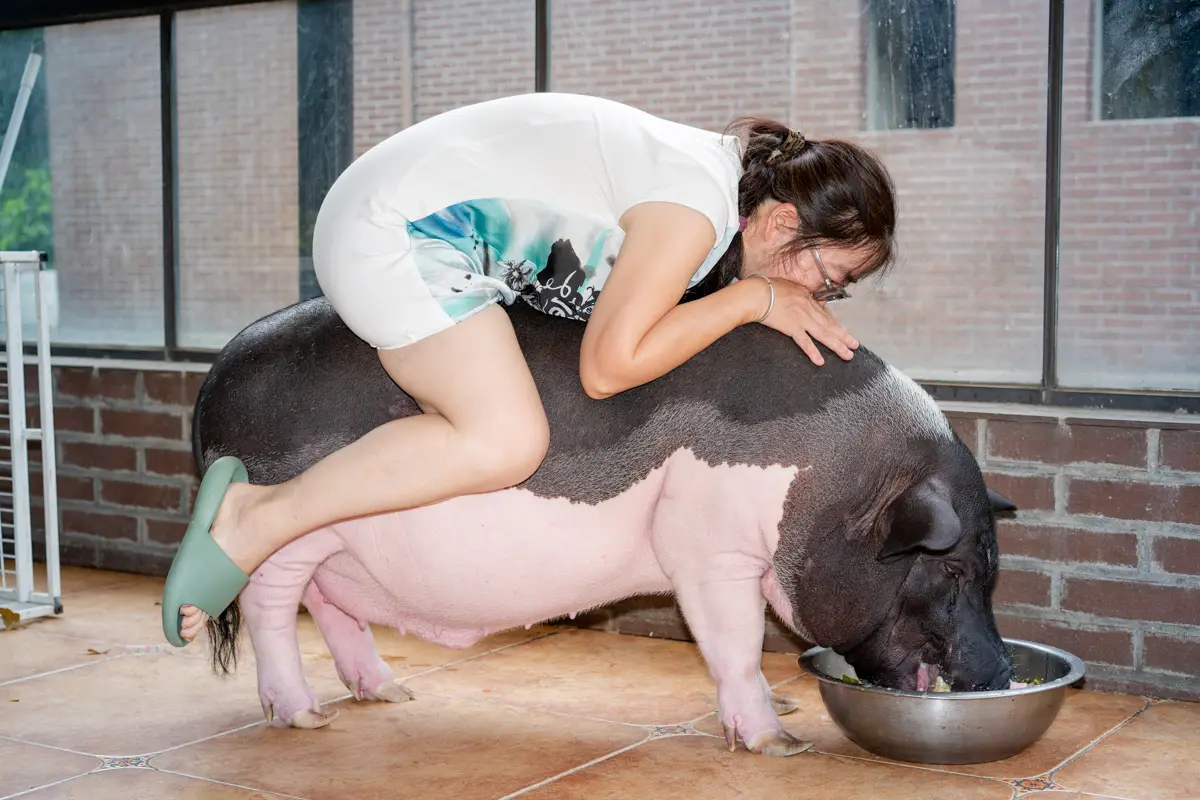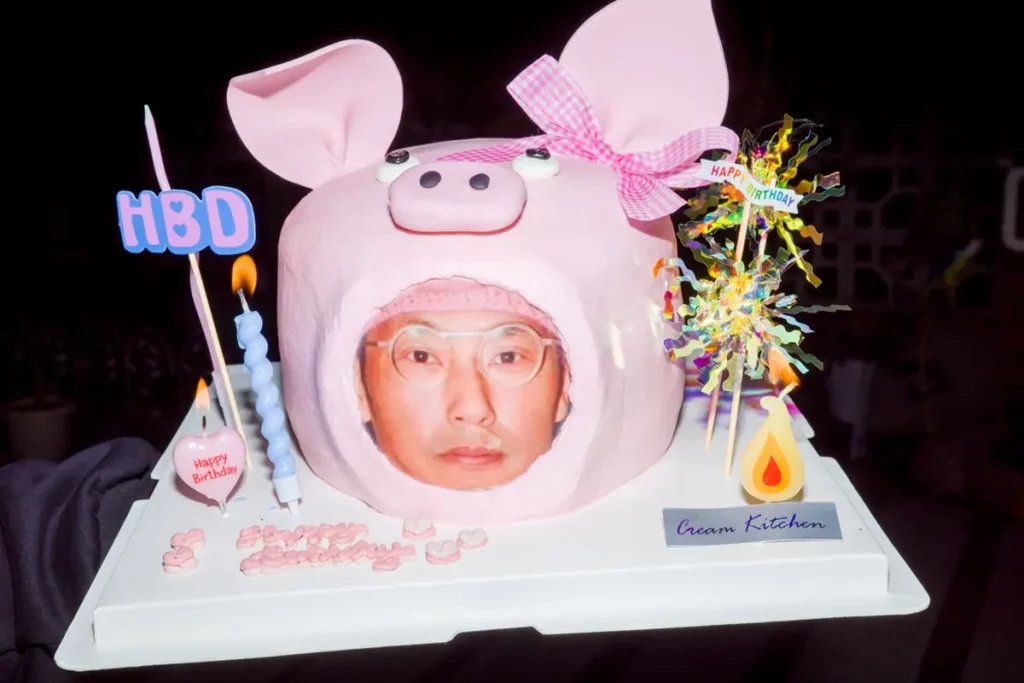Note Note Edition’s latest photographic book. The intellectual humor of Chinese photographer Feng Li and his strange relationship of friendship with his pig rescued from a tragic fate
Pets in art history: cultural diversity from Europe to the Far East
What’s better than wandering around a museum and occasionally spotting a little, fluffy animal here and there? Throughout art history, animals have played fundamental roles in the artistic production of authors of all eras and from all over the world, from north to south, from east to west. Yet while for us they are just animals, cute and cuddly, for artists, critics, and scholars, they are symbols hiding arcane meanings.
As might be expected, dogs – man’s best friend – in most Western cultures carry meanings of guidance, protection, loyalty, faithfulness, devotion, and love. In China, the famous Chinese Foo dogs were placed outside houses to prevent the entry of intruders, but also of negative energies. Cats, on the other hand, have often been associated with femininity, fertility, but also with promiscuity, laziness, and homeliness. However, it was not the same for the ancient Egyptians, who venerated cats for their abilities as hunters of harmful animals and considered them symbols of grace and benevolence towards man.
The cultural humor of Pig by Feng Li: Note Note Collection. The story of a Human-animal friendship
Guinea pigs were a signal of belonging to the upper-class, given their exotic provenance; rabbits were symbols of fertility, rebirth, resurrection; the parrots of eloquence, and so on. But what about pigs? Chinese photographer Feng Li recounts the affectionate relationship with his pig, Pig Feng JR, in a new photographic book published by Note Nite Éditions.
Simply titled Pig, the book is part of the Note Note Collection, a larger editorial project created in collaboration with journalist Sophie Pinet. Halfway between a fanzine and a book imbued with cultural humor and irony, Note Note Collection presents in images the recurring “obsessions” which inform the work of contemporary photographers. It is nothing new that throughout history, for many artists and creatives these obsessions coincided with their pets; from Salvador Dalì and his ocelot to Jackson Pollock photographed in his studio with his dog Gyp, from the super-famous Choupette – Karl Lagerfeld’s blue-cream Birman cat – up to Feng and the unusual object of his affection.
Sharing life with a pig: Feng Li’s experience – a human-animal friendship
In Pig, Feng shows an unexpected, more sensitive, and tender side of his work, while remaining faithful to the intellectual irony pervading most of his shots. At the beginning of this human-animal friendship, he would never have thought of making a piglet the subject of his photographs, much less the protagonist of a book. It was in a peaceful period of his life that he began to portray Pig Feng JR in several daily activities; from these shots a sort of family photo album was born, a collection of happy and carefree moments.
«When he was abandoned by his original owner 7 years ago, he was no bigger than a cat. At the beginning, we only adopted him temporarily and did not expect to live with him for a long time. After all, there are many unknowns in raising a pig which will grow up in a high-rise building in the city. Once we did take him in, we knew exactly what the pig’s fate would be, so we finally decided to make him a member of our family. I love to share my close relationship with the pig, and many people love seeing him on my social media», explains the photographer.
Pigs in art history, between prejudices and symbolism
In most cultures, and especially in Western countries, pigs are considered dirty, lazy, and uncouth animals, and when they were celebrated in art and literature, it was mainly because of their meat or their look, which has always aroused hilarity and humor. But many studies have actually demonstrated that pigs are extremely intelligent animals, capable of empathizing and relating to their surroundings.
«When I was young, my grandfather worked in a slaughterhouse. Every day, he killed a lot of pigs on the factory line and sent them to the market to become food on people’s tables. I never thought that many years later I would adopt a pig in my home. At first, I was worried that he was stupid and dirty, just like everyone else, but in fact, our worries were unnecessary, he was very clean and smart. In addition to the pig, my family also adopted five cats and a big parrot. I think all animals are smart, some animals are lucky enough to become people’s pets, but some unfortunately become people’s food chain».
Pig’s intellectual irony: celebrating diversity among all living beings
Through extravagant, funny, but also intimate and affectionate shots, Feng invites us to become spectators of an authentic and unconventional relationship. While also making us participants of a new perspective on the human-animal relationship: «I don’t think of animals as my pets, I think of myself as their pet. Human has mastered the fate of too many animals and plants on this earth, and countless species have disappeared because of man’s greed. In this planet we live in, life should be different, we not only need to take care of the pets around us, but we should also maintain a grateful heart, to love and treat each species».
In addition to his pig, he photographed many other animals in his daily life, without ever losing his usual intellectual irony. In his shots, animals are portrayed with seemingly human characteristics, thus acquiring a sort of anthropomorphic semblance. On the other hand, human beings embody animal instincts, conveying the message that all beings are born equal: they all love and kill each other.
Human-animal friendship. Pigs in Chinese culture: Feng Li’s Pig
A Human-animal friendship. Among the different shots that fill the pages of the book, there is one that depicts the photographer’s emotional attachment to his pig more and better than the others. This is the photograph of the pig’s head birthday cake, permeated by cultural humor and Feng’s geniality. The pig is in fact one of the twelve animals in the Chinese calendar, which is – needless to say – Feng’s zodiac sign. «I share a certain fate with the pig – Feng explains – I am the pig and the pig is me».
In the Chinese zodiac, those born under the sign of the pig are courageous and chivalrous, they never back down and are kind to others. Culturally speaking, in China pigs are considered very lucky creatures at birth. Pigs represent luck, overall good fortune, wealth, honesty, and general prosperity. In the past, small images of pigs sculpted in jade or soapstone, were often placed in the hands of the deceased to express the wish for wealth in the afterlife.
Pig: Overturning prejudices and outdated believes through the languages of art
Pig is not just the photo album of a beautiful family story, but an invitation to share their daily life through Feng’s eyes. At the time, Feng was working as a professional photographer in a government department documenting the rapid changes in urban China. During his off-duty moments at home he captured his daily life spent with the piglet, his wife, children, parrot, and cats. The shots see Pig Feng JR – which today weighs around 100 kg – taking a nap in a kennel, eating from a bowl, playing with cats.
Occasionally, photographs with pig-themed motifs pop up from the book’s pages: Feng wearing a pig costume, Pig Feng JR sleeping next to a giant golden pig-shaped balloon, and many others. Leafing through the book, it is easy to understand how creativity and artistic languages can be powerful tools for overcoming silly prejudices and promoting cultural diversity through unusual perspectives. At the end of the book, you will no longer see any difference between a puppy dog and Feng’s piglet, and you will realize that you have unconsciously trained your eye and your mind to face diversity with more curiosity and less distrust.
Feng Li’s photographic journey: from Clint Eastwood’ The Bridges of Madison Country to Pig
As a self-taught photographer, when asked about his shift in career path, Feng replies that the inspiration stems from Clint Eastwood’s famous film The Bridges of Madison Country and its Robert Kincaid character – a photojournalist for National Geographic. Today Feng is known for his works focusing on the bizarre mundanity in everyday life in China and in other townscapes, but also for his grotesque shots which capture with a subtle, cultural humor the wildest and weirdest sides of people’s nature.
Pig moves away from his previous body of work due to its delicate and genuine intellectual irony, as well as its homely atmospheres. «This project is very different from my daily work, where I mostly portray people in urban environments – explains Feng – I prefer to spend time with animals, because only with them I can acquire a pure, genuine, and not purpose-driven, mutual dependence, which goes far beyond any human relationship».
Chinese photographer Feng Li
Feng Li born in Chengdu, China, in 1971, started his career as a government civil servant before becoming an acclaimed photographic artist. Feng Li started working on his series White Night in 2005,
focusing on the bizarre mundanity in everyday life in China. He started taking commissions for fashion editorials and campaigns in 2017, such as System, The Face and 032c as well as brands such as Balenciaga, Gucci and Burberry. Feng Li has exhibited worldwide with shows in Les Rencontres de la Photographie Arles, Place M Tokyo amongst others.




















